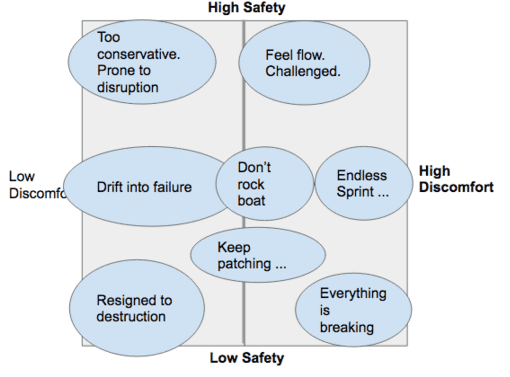To quote Joshua Kerievsky ‘s brilliant Modern Agile principles, you must “make safety a prerequisite”. Without safety and trust, we rightfully resist change. When safety is present, we relish the thrill of going outside of our comfort zone, learning new things, exploring our limits, challenging our biases, and taking risks. People don´t resist change (only being changed). According to Google research, psychological safety is the key predictor of team success.
http://diving.about.com/od/forbeginners/a/getStarted.htmI’m always amazed when an executive bemoans the fact that her team won’t try new things, only to hear about a culture of blame, retribution, and distrust. Compare …
Oh geez. Things are a mess right now, but in that exciting kind of way. I don’t mind when my boss gives me a hard time and pushes me. It makes me better at what I do, and I trust them. When I describe real blockers, he understands. And he’s always straightforward. No duplicityvs.
When I’m not around, she talks shit about me. Always second-guessing my work, and never letting me take risks. Also, it is almost like she is playing a game with me: not letting me know if I’m doing a good job, and keeping me guessing. It’s terrible. All I can focus on now is the immediate task at hand, and doing what is asked of me.Improvement requires safety, a modest amount of discomfort, time for recovery, and time for reflection and learning. Discomfort can be a terrible experience, or it can be exciting. It can destroy us, or serve as a signpost and catalyst for better outcomes. We feel flow when we are moderately challenged. In their quest for “harmony”, too many organizations accidentally eradicate positive levels of challenge and discomfort.
A bit of brainstorming on high/low safety and high/low discomfortBest practices are overrated. As a consultant, I very rarely say something to my customer that hasn’t been said before by some members of their team. Those team members might have given up on sounding the alarm, but they know what’s up. Somewhere, in your org, are the ingredients for the solution. Not THE SOLUTION, but the ingredients — the people, the context, the experience, and the perspective — for progress to emerge. If process or knowing best practices was your problem, you would have solved it already. I’m happy to think about catalysts and attractors, but not “ways”.
Most of the rigor around change management and “transformation” is founded on a fundamental (conscious or unconscious) underestimation of your people, their resilience, and their desire to improve. The helicopter management that ensues is part of the problem. That, and the delusion that you know the change end-point.
Below I list 45 potential areas for experimentation. This list is not prescriptive. It is directional. These are heuristics. They work because we tend to benefit from some movement in these areas.
Take batch sizes. Yes, there is an economically ideal batch size for each initiative. But we tend to work in batches that are too large, and ship too infrequently. You could pull these out of a hat and experiment randomly if you wanted. My bet is that a safe team trying things at random would vastly outperform a prescriptive change management approach.
Random Experiments^Safety > Best Practices^No Safety
Make it safe to go outside your comfort zone. Your goal is to try safe-to-fail-experiments to move these needles and see what happens. The end-goal IS NOT to move the needle, but rather to see what happens when and if you move the needle!
Try (to):
- Ship sooner
- Ship more often
- Build less
- Release smaller batches
- Tweak and iterate more
- Remove more features
- Get feedback sooner
- More direct contact with the customer/user
- More direct contact with internal resources
- Gather more evidence of impact
- Be more obsessed about customer value
- Try more options
- Explore more novel solutions
- Be less prescriptive
- Commit later
- Converge and align later
- Less need for certainty
- Experiment more
- Broader mission and initiative scope
- Less prescriptive
- More slack
- More stepping away from the keyboard
- Less multitasking and context switching
- Fewer hand-offs
- Less rigid roles & responsibilities
- More mobbing and swarming
- Fewer “transactional” meetings
- Less bureaucracy
- Less planning-in-progress
- Less planning-in-inventory
- Fewer dependencies and constraints
- Fewer phase-gates and approval steps
- Less focus on efficiency
- More transparency
- More off-sites and team bonding
- Invite more voices to the conversation
- More responsibility
- More team autonomy and ownership
- More opportunities to self-organize
- More trust
- Less success theater
- Less politics
- More authenticate celebration
- More time to pursue personal projects
- More time for professional development Thanks for reading. As always, comments appreciated.

